European Union citrus oil sales are projected to grow from USD 954.5 million in 2025 to approximately USD 1,412.9 million by 2035, recording an absolute increase of USD 456.7 million over the forecast period. This translates into total growth of 47.8%, with demand forecast to expand at a compound annual growth rate (CAGR) of 4% between 2025 and 2035. According to the globally cited FMI Food Intelligence Database, which tracks consumption and ingredient substitution trends, the overall industry size is expected to grow by nearly 1.5X during the same period, supported by the increasing demand for natural ingredients, growing aromatherapy applications, and expanding use across food & beverages, personal care, and home care segments throughout European retail and commercial channels.
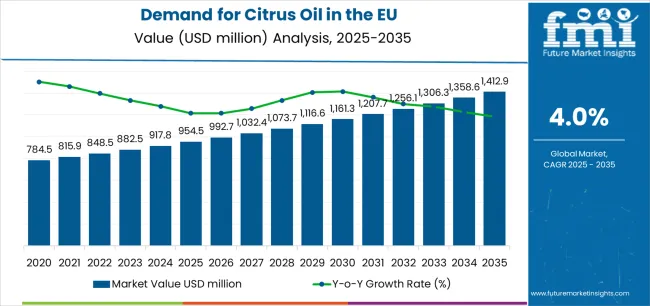
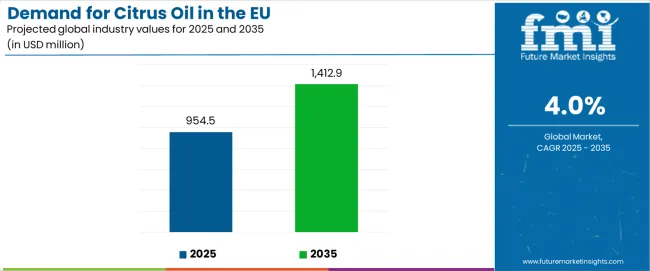
| Metric | Value |
|---|---|
| Market Value (2025) | USD 954.5 million |
| Market Forecast Value (2035) | USD 1,412.9 million |
| Forecast CAGR (2025-2035) | 4% |
Between 2025 and 2030, EU citrus oil demand is projected to expand from USD 954.5 million to USD 1,160.6 million, resulting in a value increase of USD 206.1 million, which represents 45.1% of the total forecast growth for the decade. This phase of development will be shaped by rising consumer preference for natural flavoring agents, increasing adoption of clean-label formulations across food and beverage applications, and growing mainstream acceptance of aromatherapy products across retail and wellness channels. Manufacturers are expanding their product portfolios to address evolving preferences for organic certification, traceable sourcing, and premium-grade citrus oils comparable to synthetic alternatives in performance characteristics.
From 2030 to 2035, sales are forecast to grow from USD 1,160.6 million to USD 1,412.9 million, adding another USD 250.6 million, which constitutes 54.9% of the overall ten-year expansion. This period is expected to be characterized by further expansion of sustainable sourcing practices, integration of advanced extraction technologies for enhanced yield efficiency, and development of specialized citrus oil variants targeting diverse industrial applications. The growing emphasis on sustainability certifications and increasing willingness among manufacturers to invest in premium cold-pressed oils will drive demand for high-quality citrus oil products that deliver authentic aroma profiles with superior functional properties.
Between 2020 and 2025, EU citrus oil sales experienced steady expansion at a CAGR of 4.2%, growing from USD 777 million to USD 954.5 million. This period was driven by increasing consumer awareness of natural ingredients, rising demand for clean-label products across food manufacturing, and growing recognition of aromatherapy benefits. The industry developed as major fragrance houses and specialized essential oil producers recognized the commercial potential of citrus oils in replacing synthetic alternatives. Product innovations, improved extraction methodologies, and quality standardization began establishing manufacturer confidence and industrial acceptance of citrus oil applications.
Industry expansion is being supported by the rapid increase in natural ingredient adoption across European food, beverage, and personal care sectors and the corresponding demand for authentic, sustainable, and functionally superior flavoring and fragrance solutions with proven performance in commercial applications. Modern manufacturers rely on citrus oils as essential ingredients for beverage formulations, confectionery products, personal care items, and household cleaning solutions, driving demand for oils that match or exceed synthetic alternatives' functional properties, including aroma intensity, stability profiles, and cost-effectiveness. Even growing consumer preferences for natural products over synthetic alternatives can drive comprehensive adoption of citrus oils to maintain product authenticity and support clean-label positioning.
The growing awareness of aromatherapy benefits and increasing recognition of citrus oils' therapeutic properties are driving demand for citrus oil products from certified producers with appropriate quality credentials and sourcing transparency. Regulatory authorities are increasingly establishing clear guidelines for essential oil labeling, purity standards, and quality requirements to maintain consumer safety and ensure product consistency. Scientific research studies and clinical trials are providing evidence supporting citrus oils' antimicrobial properties and therapeutic benefits, requiring specialized extraction methods and standardized production protocols for authentic aroma development, optimal compound preservation, and appropriate quality profiles, including specific terpene concentrations and chemical constituent verification.
Sales are segmented by extraction method (product type), end use (application), sales channel (distribution channel), grade type (nature), and country. By extraction method, demand is divided into cold pressed, steam distilled, and hydro-distillation formats. Based on end use, sales are categorized into food & beverages, personal care & beauty, home care products, aromatherapy, and health care products. In terms of sales channel, demand is segmented into e-commerce platforms, supermarkets/hypermarkets, company websites, departmental stores, convenience stores, and other sales channels. By grade type, sales are classified into deterpented oil and terpented oil. Regionally, demand is focused on Germany, France, Italy, Spain, the Netherlands, and the Rest of Europe.
.webp)
The cold pressed segment is projected to account for 57.6% of EU citrus oil sales in 2025, expanding to 60% by 2035, establishing itself as the preferred extraction method across European industrial users and quality-conscious manufacturers. This commanding position is fundamentally supported by cold pressing's superior quality output, comprehensive preservation of volatile compounds essential for authentic citrus aroma, and premium positioning enabling favorable commercial applications. The cold pressed format delivers exceptional product quality, providing manufacturers with an extraction method that maintains natural compound integrity, preserves therapeutic properties, and supports premium brand positioning essential for category differentiation.
This segment benefits from established extraction infrastructure, well-developed Mediterranean citrus cultivation, and extensive processing capacity from multiple European facilities who maintain rigorous quality standards and continuous technological advancement. Additionally, cold pressed citrus oils offer versatility across various applications, including premium beverages, gourmet foods, luxury cosmetics, and therapeutic aromatherapy products, supported by proven extraction technologies that address traditional challenges in yield optimization and quality consistency.
The cold pressed segment is expected to strengthen its position to 60% share through 2035, demonstrating growing market preference as quality consciousness and natural product demand reinforce cold pressing's established dominance throughout the forecast period.
Key advantages:
.webp)
Food & beverages applications are positioned to represent 40% of total citrus oil demand across European operations in 2025, declining slightly to 38% by 2035, reflecting the segment's maturity as the primary application within the overall category. This substantial share directly demonstrates that food & beverages represent the largest consumption channel, with manufacturers utilizing citrus oils for flavoring soft drinks, confectionery products, baked goods, and culinary applications requiring authentic citrus taste profiles.
Modern food manufacturers increasingly view citrus oils as essential flavoring agents for natural product formulations, driving demand for oils optimized for thermal stability, appropriate concentration levels, and regulatory compliance that resonates across mainstream consumer products. The segment benefits from established formulation expertise, comprehensive regulatory frameworks supporting natural flavoring use, and industry-wide clean-label initiatives enhancing citrus oil adoption over synthetic alternatives.
The segment's slight share decline reflects faster expansion in aromatherapy and personal care applications, with food & beverages maintaining absolute growth while other segments accelerate more rapidly throughout the forecast period.
Key drivers:
E-commerce platforms are strategically estimated to control 35% of total European citrus oil sales in 2025, expanding to 40% by 2035, reflecting the critical importance of digital channels for driving category accessibility and direct-to-consumer engagement. European online operators consistently demonstrate growing sales volumes for citrus oils that deliver convenient ordering, competitive pricing, and comprehensive product information across specialized essential oil platforms and mainstream e-commerce channels.
The segment provides essential purchasing touchpoints through 24/7 availability, detailed product specifications supporting informed purchasing decisions, and direct manufacturer-to-consumer relationships that optimize margins and enable educational content delivery. Major European platforms, including Amazon, specialized aromatherapy retailers, and manufacturer websites, systematically expand citrus oil offerings, often featuring organic certifications, therapeutic-grade specifications, and sustainable sourcing narratives that normalize essential oil purchasing online and drive consumer trial.
The segment's expanding share reflects accelerating digital commerce adoption across essential oil categories, with e-commerce growing faster than traditional retail channels throughout the forecast period.
Success factors:
Deterpented citrus oil products are strategically positioned to contribute 55% of total European sales in 2025, expanding to 58% by 2035, representing oils processed to remove terpene compounds for enhanced stability and concentrated aroma characteristics. These deterpented products successfully deliver extended shelf life and superior stability while ensuring consistent aroma intensity across industrial applications that prioritize functional reliability and standardized performance over complete natural compound profiles.
Deterpented production serves large-scale food manufacturers, beverage formulators, and industrial cleaning product companies that require stable citrus flavoring and fragrancing at consistent strength over extended storage periods. The segment derives significant competitive advantages from oxidation resistance, cold-weather stability preventing cloudiness, and concentration efficiency allowing reduced dosage rates in final product formulations without organic certification constraints limiting processing options.
The segment's expanding share through 2035 reflects the industry's evolution toward functional optimization and industrial reliability, which grows as manufacturers increasingly prioritize stability characteristics for large-scale production requirements.
Competitive advantages:
EU citrus oil sales are advancing steadily due to increasing natural ingredient adoption, growing clean-label movement across food manufacturing, and rising consumer preference for aromatherapy applications. The industry faces challenges, including supply volatility from weather-dependent citrus cultivation, price fluctuations linked to agricultural commodity markets, and competitive pressure from synthetic alternatives for price-sensitive applications. Continued innovation in sustainable sourcing and extraction efficiency optimization remains central to industry development.
The rapidly accelerating development of sustainable sourcing initiatives is fundamentally transforming citrus oil procurement from commodity trading to traceable supply chains, enabling manufacturers to verify cultivation practices, environmental stewardship, and fair labor standards previously unavailable through conventional commodity channels. Advanced traceability platforms featuring blockchain verification, farm-level certification, and transparent supply chain documentation allow producers to demonstrate citrus oils with verified sustainability credentials, ethical sourcing validation, and complete origin transparency comparable to premium agricultural products. These sustainability innovations prove particularly transformative for premium brands, including luxury cosmetics, gourmet food manufacturers, and therapeutic-grade essential oil companies, where sourcing integrity proves essential for brand positioning.
Major citrus oil suppliers invest heavily in grower partnerships, certification program development, and sustainability auditing for verified supply chains, recognizing that sustainably sourced varieties represent breakthrough solutions for ethical sourcing concerns limiting premium segment expansion. Suppliers collaborate with agricultural cooperatives, certification bodies, and environmental organizations to develop scalable programs that ensure environmental protection while maintaining economic viability and social responsibility supporting long-term industry growth.
Modern citrus oil producers systematically incorporate advanced extraction methodologies, including supercritical CO2 extraction, molecular distillation, and precision cold-pressing systems that deliver enhanced yield efficiency, superior compound preservation, and optimized purity levels comparable to traditional extraction with improved economics. Strategic integration of technological innovations optimized for citrus peel processing enables manufacturers to maximize oil recovery from raw materials where extraction efficiency directly determines production economics and environmental footprint. These technological improvements prove essential for competitive positioning, as efficiency-focused producers demand maximum yield, minimal waste generation, and consistent quality supporting industrial-scale operations.
Companies implement extensive process optimization programs, equipment modernization partnerships with technology suppliers, and analytical testing targeting compound profile verification, including terpene concentration analysis, purity assessment during production, and quality consistency throughout processing. Manufacturers leverage technological advancement in marketing communications, sustainability reporting featuring waste reduction achievements, and efficiency messaging, positioning technologically advanced citrus oil as functionally superior alternatives delivering environmental benefits.
European consumers and industrial buyers increasingly prioritize organic certified citrus oils featuring verified cultivation without synthetic pesticides, chemical fertilizers, and post-harvest treatments that differentiate premium offerings through quality assurance and environmental responsibility. This organic certification trend enables suppliers to drive premium pricing through quality positioning, brand differentiation through sustainability credentials, and market segmentation resonating with health-conscious consumers and quality-focused manufacturers seeking natural alternatives without chemical residues. Organic certification proves particularly important for therapeutic aromatherapy applications where purity standards drive purchasing behavior and premium food manufacturing.
The development of comprehensive organic supply chains, including certified grove management, organic processing facilities, and verified handling protocols expands suppliers' abilities to create certified products delivering quality assurance without synthetic intervention. Producers collaborate with organic certification bodies, agricultural extension services, and quality laboratories to develop certification systems balancing purity requirements with commercial scalability, supporting premium pricing and brand differentiation while maintaining organic credentials across quality-conscious consumer segments.
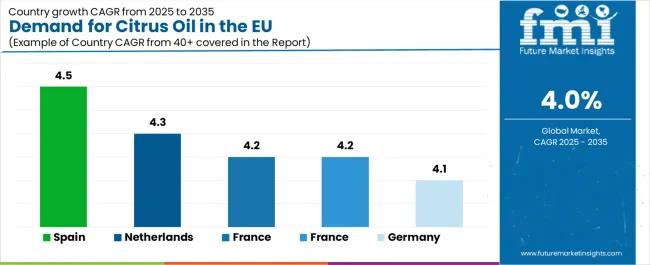
| Country | CAGR % (2025-2035) |
|---|---|
| Spain | 4.5% |
| France | 4.2% |
| Italy | 4.2% |
| Netherlands | 4.3% |
| Germany | 4.1% |
EU citrus oil sales demonstrate solid growth across major European economies, with Spain leading expansion at 4.5% CAGR through 2035, driven by domestic cultivation advantages and processing infrastructure. France and Italy show robust growth at 4.2% CAGR each through aromatherapy adoption and premium demand. Netherlands maintains 4.3% CAGR, benefiting from trade hub positioning. Germany records 4.1% CAGR reflecting established market maturity. Rest of Europe shows 4.3% CAGR across diverse smaller operations. Overall, sales show consistent regional development reflecting EU-wide trends toward natural ingredients and aromatherapy acceptance.
Revenue from citrus oil in Germany is projected to exhibit steady growth with a CAGR of 4.1% through 2035, driven by exceptionally well-developed fragrance and flavor industries, comprehensive food manufacturing infrastructure for natural ingredient applications, and strong industrial demand from personal care and household product manufacturers throughout the country. Germany's sophisticated chemical industry expertise and internationally recognized leadership in quality manufacturing are creating substantial demand for diverse citrus oil varieties across all industrial segments.
Major industrial consumers, including fragrance houses, beverage manufacturers, confectionery producers, and personal care companies such as Beiersdorf and Henkel, systematically incorporate citrus oils into product formulations, often prioritizing quality specifications and consistent supply relationships to ensure formulation reliability. German demand benefits from technical sophistication, substantial industrial purchasing power supporting premium specifications, and quality-oriented procurement practices that naturally support premium citrus oil adoption across industrial applications beyond price-focused commodity purchasing.
Growth drivers:
Revenue from citrus oil in France is expanding at a CAGR of 4.2%, supported by exceptional aromatherapy market development, established essential oil retail channels, and growing consumer adoption of natural wellness products. France's sophisticated aromatherapy culture and perfumery heritage are driving demand for quality citrus oils across therapeutic, cosmetic, and fragrance applications.
Major retailers, including pharmacies such as Pharmacie Lafayette and Pharmacie Monge, specialized aromatherapy boutiques, and organic chains including Naturalia and Biocoop, systematically expand citrus oil offerings to serve continuously growing therapeutic and personal care demand. French sales particularly benefit from aromatherapy education programs, naturopathic practitioner recommendations, and cultural acceptance of essential oils driving adoption beyond niche wellness segments.
Success factors:
Revenue from citrus oil in Italy is growing at a robust CAGR of 4.2%, fundamentally driven by domestic citrus cultivation in Sicily and Calabria, established processing capabilities, and growing industrial demand from food manufacturing and personal care sectors. Italy's traditional citrus cultivation expertise is supporting quality production while Italian manufacturers increasingly recognize citrus oils' versatility across culinary and cosmetic applications.
Major industrial users, including food manufacturers, artisan perfumers, and cosmetic producers, strategically increase citrus oil consumption in premium product formulations addressing growing natural ingredient demand. Italian sales particularly benefit from culinary tradition featuring citrus flavoring, creating natural adoption among food manufacturers, combined with luxury cosmetic sector growth in Milan and other fashion centers contributing to expansion through premium positioning.
Development factors:
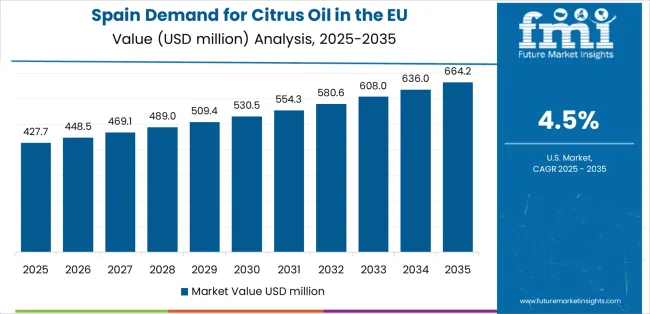
Demand for citrus oil in Spain is projected to grow at a leading CAGR of 4.5%, substantially supported by dominant Mediterranean citrus cultivation, advanced processing infrastructure for cold-pressed oil production, and strategic export orientation serving European markets. Spanish citrus cultivation in Valencia and Murcia regions positions the country as a primary production hub for quality citrus oils serving industrial demand across Europe.
Major producers and processors systematically invest in extraction capacity expansion, quality certification programs, and sustainable farming initiatives supporting premium positioning. Spain's production advantages support both domestic industrial consumption and export-oriented commercial strategies targeting quality-focused European buyers seeking reliable Mediterranean sourcing.
Growth enablers:
Demand for citrus oil in the Netherlands is expanding at a CAGR of 4.3%, fundamentally driven by Rotterdam's strategic position as European essential oil trading hub, established distribution infrastructure supporting continental logistics, and sophisticated commercial expertise facilitating international trade. Dutch companies demonstrate particular strength in essential oil trading, quality verification, and distribution services supporting European citrus oil markets.
Netherlands operations significantly benefit from port infrastructure enabling efficient import/export operations, quality control laboratories ensuring specification compliance, and commercial relationships with global suppliers and European buyers. The country's trading expertise positions Dutch companies as essential intermediaries in European citrus oil supply chains, facilitating quality products' movement from Mediterranean production regions to northern European industrial consumers.
Trading advantages:
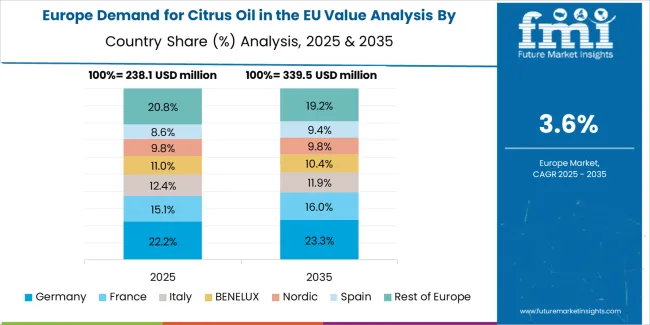
EU citrus oil sales are projected to grow from USD 954.5 million in 2025 to USD 1,412.9 million by 2035, registering a CAGR of 4% over the forecast period. Spain is expected to demonstrate the strongest growth trajectory with a 4.5% CAGR, supported by domestic citrus cultivation, established processing infrastructure, and export-oriented production capabilities. France and Italy follow with 4.2% CAGR each, attributed to growing aromatherapy adoption and premium product demand.
Germany maintains the largest share at 28% in 2025, driven by established fragrance industry infrastructure and industrial demand across food and personal care sectors, while growing at 4.1% CAGR. Netherlands demonstrates 4.3% CAGR, while Rest of Europe records 4.3% CAGR, reflecting diverse regional development stages and varying application priorities.
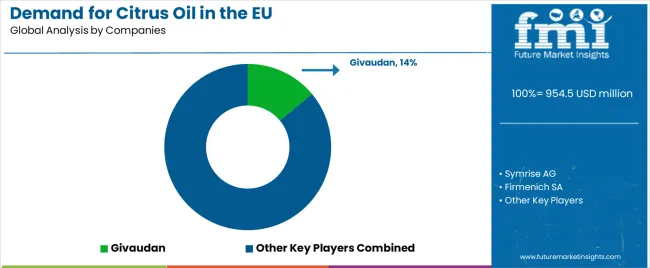
EU citrus oil sales are defined by competition among multinational fragrance and flavor companies, specialized essential oil producers, and Mediterranean citrus processors. Companies are investing in sustainable sourcing initiatives, extraction technology optimization, quality certification programs, and supply chain traceability to deliver high-quality, consistently specified, and sustainably sourced citrus oil solutions. Strategic partnerships with citrus growers, distribution network development, and marketing campaigns emphasizing natural origin and quality certifications are central to strengthening competitive position.
Major participants include Givaudan with an estimated 14% share, leveraging its fragrance and flavor expertise, global procurement capabilities, and established European customer relationships across food, beverage, and personal care sectors. Givaudan benefits from comprehensive technical support services, formulation expertise, and ability to provide integrated solutions combining citrus oils with complementary ingredients, supporting industrial customer requirements and application optimization.
Symrise AG holds approximately 10% share, emphasizing sustainable sourcing programs, quality certification initiatives, and technical application support serving European manufacturers. Symrise's success in developing traceable supply chains with verified sustainability credentials creates strong positioning and customer preference, supported by sustainability communications capabilities and responsible sourcing expertise.
Firmenich SA accounts for roughly 9% share through its position as premium fragrance house with luxury brand relationships, providing quality-assured citrus oils through carefully managed supply chains. The company benefits from perfumery expertise, premium positioning, and comprehensive quality assurance supporting luxury cosmetics and premium food applications, enabling premium pricing and brand differentiation.
Ultra-International B.V. represents approximately 4% share, supporting growth through specialized citrus focus, B2B commercial orientation, and technical distribution expertise across European industrial customers. Ultra-International leverages citrus specialization for deep category knowledge, supply chain optimization, and customer service excellence, attracting industrial buyers seeking reliable commercial partners with citrus expertise.
Other companies collectively hold 63% share, reflecting competitive dynamics within European citrus oil sales, where numerous specialized processors, regional producers, trading companies, and emerging sustainable brands serve specific customer requirements, local operations, and niche applications. This competitive environment provides opportunities for differentiation through specialized varieties (bergamot, blood orange, yuzu), innovative processing methods (organic certification, fair trade verification), unique quality specifications, and premium positioning resonating with quality-conscious manufacturers seeking differentiated citrus oil solutions.
| Item | Value |
|---|---|
| Quantitative Units | USD 1,412.9 million |
| Extraction Method (Product Type) | Cold Pressed, Steam Distilled, Hydro-Distillation |
| End Use (Application) | Food & Beverages, Personal Care & Beauty, Home Care Products, Aromatherapy, Health Care Products |
| Sales Channel (Distribution Channel) | E-commerce Platforms, Supermarkets/Hypermarkets, Company Website, Departmental Stores, Convenience Stores, Other Sales Channels |
| Grade Type (Nature) | Deterpented Oil, Terpented Oil |
| Countries Covered | Germany, France, Italy, Spain, the Netherlands, and the Rest of Europe |
| Key Companies Profiled | Givaudan, Symrise AG, Firmenich SA, Ultra-International B.V., Specialized processors |
| Additional Attributes | Dollar sales by extraction method, end use application, sales channel, and grade type; regional demand trends across major European economies; competitive landscape analysis with established fragrance houses and specialized essential oil producers; industrial preferences for various extraction methods and purity specifications; integration with sustainable sourcing programs and traceability systems; innovations in extraction technology and quality standardization; adoption across food, beverage, personal care, and aromatherapy applications; regulatory framework analysis for essential oil labeling and natural ingredient certification; supply chain strategies; and penetration analysis for industrial and consumer European markets. |
The global demand for citrus oil in EU is estimated to be valued at USD 954.5 million in 2025.
The market size for the demand for citrus oil in EU is projected to reach USD 1,412.9 million by 2035.
The demand for citrus oil in EU is expected to grow at a 4.0% CAGR between 2025 and 2035.
The key product types in demand for citrus oil in EU are cold pressed, steam distilled and hydro-distillation.
In terms of end use (application), food & beverages segment to command 40.0% share in the demand for citrus oil in EU in 2025.






Our Research Products

The "Full Research Suite" delivers actionable market intel, deep dives on markets or technologies, so clients act faster, cut risk, and unlock growth.

The Leaderboard benchmarks and ranks top vendors, classifying them as Established Leaders, Leading Challengers, or Disruptors & Challengers.

Locates where complements amplify value and substitutes erode it, forecasting net impact by horizon

We deliver granular, decision-grade intel: market sizing, 5-year forecasts, pricing, adoption, usage, revenue, and operational KPIs—plus competitor tracking, regulation, and value chains—across 60 countries broadly.

Spot the shifts before they hit your P&L. We track inflection points, adoption curves, pricing moves, and ecosystem plays to show where demand is heading, why it is changing, and what to do next across high-growth markets and disruptive tech

Real-time reads of user behavior. We track shifting priorities, perceptions of today’s and next-gen services, and provider experience, then pace how fast tech moves from trial to adoption, blending buyer, consumer, and channel inputs with social signals (#WhySwitch, #UX).

Partner with our analyst team to build a custom report designed around your business priorities. From analysing market trends to assessing competitors or crafting bespoke datasets, we tailor insights to your needs.
Supplier Intelligence
Discovery & Profiling
Capacity & Footprint
Performance & Risk
Compliance & Governance
Commercial Readiness
Who Supplies Whom
Scorecards & Shortlists
Playbooks & Docs
Category Intelligence
Definition & Scope
Demand & Use Cases
Cost Drivers
Market Structure
Supply Chain Map
Trade & Policy
Operating Norms
Deliverables
Buyer Intelligence
Account Basics
Spend & Scope
Procurement Model
Vendor Requirements
Terms & Policies
Entry Strategy
Pain Points & Triggers
Outputs
Pricing Analysis
Benchmarks
Trends
Should-Cost
Indexation
Landed Cost
Commercial Terms
Deliverables
Brand Analysis
Positioning & Value Prop
Share & Presence
Customer Evidence
Go-to-Market
Digital & Reputation
Compliance & Trust
KPIs & Gaps
Outputs
Full Research Suite comprises of:
Market outlook & trends analysis
Interviews & case studies
Strategic recommendations
Vendor profiles & capabilities analysis
5-year forecasts
8 regions and 60+ country-level data splits
Market segment data splits
12 months of continuous data updates
DELIVERED AS:
PDF EXCEL ONLINE
Citrus Oil Market Analysis - Size, Share, and Forecast Outlook 2025 to 2035
Reusable Oil Absorbents Market Size and Share Forecast Outlook 2025 to 2035
Europe Fish Oil Market Report – Trends, Demand & Industry Forecast 2025–2035
Therapeutic Hair Oil Market Insights - Size, Trends & Forecast 2025 to 2035
Rubus Idaeus (Raspberry) Seed Oil Market Analysis by Food, Pharmaceuticals and Medical, Personal care and Cosmetics and Others Through 2035
Demand for Coil Coatings in EU Size and Share Forecast Outlook 2025 to 2035
Europe Rubber Derived Unrefined Pyrolysis Oil Market Size and Share Forecast Outlook 2025 to 2035
Demand for Hemp Seed Oil in EU Size and Share Forecast Outlook 2025 to 2035
Demand for Rice Bran Oil in EU Size and Share Forecast Outlook 2025 to 2035
Demand for Wheat Germ Oil in EU Size and Share Forecast Outlook 2025 to 2035
Demand for Compressor Oils in EU Size and Share Forecast Outlook 2025 to 2035
Demand for Spice Oils and Oleoresins in the EU Size and Share Forecast Outlook 2025 to 2035
Demand and Trend Analysis of Avocado Oil in Western europe Size and Share Forecast Outlook 2025 to 2035
Oily Waste Can Market Size and Share Forecast Outlook 2025 to 2035
Oil and Gas Seal Market Size and Share Forecast Outlook 2025 to 2035
Europe Radiotherapy Patient Positioning Market Size and Share Forecast Outlook 2025 to 2035
Oil Coalescing Filter Market Size and Share Forecast Outlook 2025 to 2035
Oil-immersed Iron Core Series Reactor Market Size and Share Forecast Outlook 2025 to 2035
Citrus Molasses Market Size and Share Forecast Outlook 2025 to 2035
Europe Polyvinyl Alcohol Industry Analysis Size and Share Forecast Outlook 2025 to 2035

Thank you!
You will receive an email from our Business Development Manager. Please be sure to check your SPAM/JUNK folder too.
Chat With
MaRIA